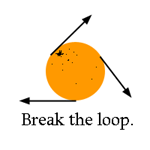

 | Tangentium |
May '05: Menu
All material on this site remains © the original authors: please see our submission guidelines for more information. If no author is shown material is © Drew Whitworth. For any reproduction beyond fair dealing, permission must be sought: e-mail drew@comp.leeds.ac.uk. ISSN number: 1746-4757 |
Higher Education and Information Technology: Defining the RelationshipRajesh Kumar SharmaPage 1 ¦ Page 2 ¦ Printer-friendly version The human being is after all more than a mere processor with an accidental spark of consciousness. In our infatuation with models, we tend to forget that higher education does not so much denote hierarchy envisaged in terms of structural design as the nobility and distance of ideals. We tend to forget that higher education is the space in which a civilization conducts dialogue with its memories and charts its future trajectories. That it is the space in which the intellectual conscience of a society articulates and confronts itself. Higher education, in other words, cannot be visualised except as, fundamentally, an institutionalised public space for rigorous reflection, including self-reflection. In the larger enterprise known as higher education, the role of the humanities is thus crucial; for it is here that the institution of knowledge meets its own conscience. Substituting the sublime inner spaces of the humanities with manageable information 'bits' amounts, for this reason, to dehumanizing the great adventure of knowledge (which presumes a human being who would 'know') and reducing education to the mechanics of friction-free data processing. The ethics of scientific research, the repercussions of globalization and the traffic rules of the information superhighway are matters for thought, not for data processing, and require new engagements between the sciences and the humanities. They will always elude the algorithmic grasp of the information technology paradigm because they require not machines that are programmed to react in given ways but people who are trained to reflect intellectually and imaginatively. Information can be of great assistance here. But the plain fact that by itself information technology cannot self-reflect should be sufficient to disqualify it from staking any claim on either the central space or the paradigmatic architectonics of higher education. Ideally, the easy and instantaneous access to vast amounts of information should fit nicely into the project of education. Faster processing and better information management should, of course, help education. In practice, however, a slippage takes place: processing insinuates itself into the place of education and displaces it. This is likely to occur more frequently with increasing shrinkage of the space for 'idle' thought, given the imperatives of a knowledge 'economy' which is modelled on information management systems. Among the things that may be done to prevent the slippage is, as Jeffrey D. Sachs points out, focussing not on disciplines but on problems. [6] Tools and paradigms should automatically fall into place because the right focus would mobilize the right priorities. The complexity of the human situation today demands highly complex responses. Any worthwhile grasp of the situation depends on the comprehensiveness and speed of the information available, in which information technology can help enormously. But the ethical choices have to be made by real people. The second thing required is radical restructuring of the institutions of higher education so that they can absorb the new forces which information technology is generating. This requires reconfiguring scholarship and the pedagogical practices. Should the academy be slow in doing this, the opportunity would be most likely hijacked by the non-academic 'knowledge-providers' in the marketplace. [7] The consequence could well be an unchecked trivialization and commodification of knowledge, a frightening prospect in which we leap into an electronic next version of the Dark Ages, with all that legacy of the Enlightenment simply wiped out at a so-called higher plane of the spiral. The institutional restructuring would have to include a bolder plunge into collaborative effort and interdisciplinarity, something again forced by the speed and sweep of information technology. Already the major breakthroughs are happening at the boundaries as information technology makes it imperative and even easier to cross the boundaries and reach out to new knowledges. The democracy of knowledge also goes into a faster update mode, with a consequent leveling up (not down) as the grand architecture of the ivory tower gives way to the nano-architecture of interconnected neural pathways. The costs of universal access to good education should also come down eventually as the content and quantity improve and the pedagogic waste is minimized. Indeed, the accumulation and better distribution of the intellectual capital directly depends on free access to information capital and on improvement in the small savings of time, something that information technology alone can help us achieve so fast. The future, then, lies in integration, no doubt. But it certainly does not lie in integration as the disappearance of education into information technology. That, however, is what the hawkers of information technology at the service of a soulless global electronic capitalist order are marketing for now, evoking the seductive dreams of an electronic Elysium. The future lies in the integration of information technology in education envisaged as the grand and open universal project of human self-reconstruction and invention. Footnotes6. See Davidson and Goldberg, A Manifesto for the Humanities, op. cit. return 7. Scores of companies in India have over the last more than ten years exploited the IT dream and fleeced thousands of unemployed and desperate young people by offering a poor apology for IT training for incredibly exorbitant fees. return | |